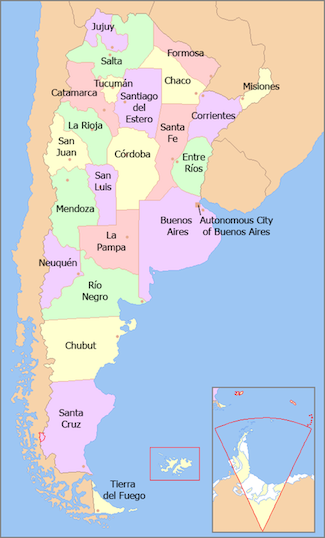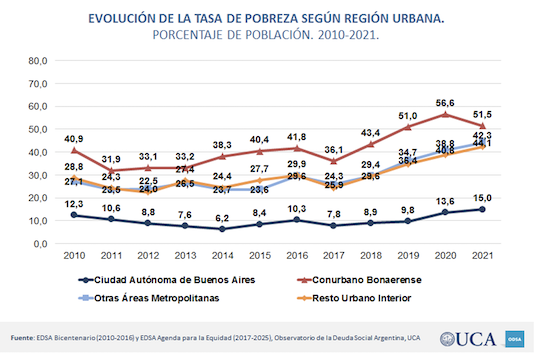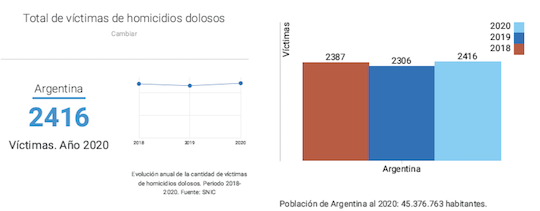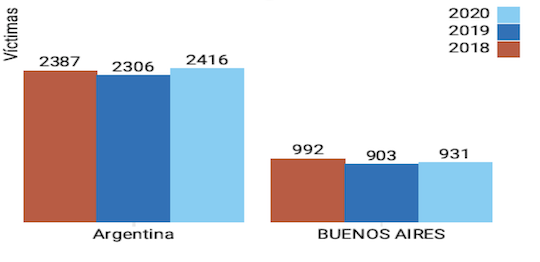Drugs, Drug Trafficking, and Pandemic in Argentina

Drugs, Drug Trafficking, and Pandemic in Argentina
Pablo A. Baisotti
This article is available en español here.
This article looks at impact of the Covid-19 pandemic on drug related crime and violence in Argentina.[1] Contrary to what was assumed at the beginning of the pandemic, drug trafficking in Argentina found a profitable situation for expansion in various regions of the country, especially in the conurbano bonaerense, the suburbs or Greater Buenos Aires surrounding the Autonomous City of Buenos Aires (Ciudad Autónoma de Buenos Aires – CABA)—the poorest area of Buenos Aires (although not all of this region is poor)—and Rosario and its surroundings, in the province of Santa Fe (see Figure 1). The growth was sustained by the health situation, the weakness of the state with growing corruption, and the increase in demand for drugs. Two visible consequences were the resurgence of criminal “gang wars” and the low quality of drugs (most of them adulterated), which caused casualties among citizens, (due to consumption and insecurity).

Figure 1. Map of Argentina with provinces. Public domain
Introduction
According to the United Nations, at the global level, drug trafficking generates a volume of between $400–600 billion per year, equivalent to 10% of global trade.[2] There is a profusion of international legislation against drug trafficking, although this has not led to a decrease in trade, production, and consumption; moreover, it seems that the figures of sale and consumption continue to expand.[3]
Based on a 2017 study by the former subsecretario de Lucha contra el Narcotráfico (Undersecretary for the Fight against Drug Trafficking) in Argentina, Martin Verrier, some US $1.1 billion were traded in the country; corresponding US $500 million to the marijuana business and US $218 million to the cocaine business. The economic crisis, which has deepened since 2019 and has hit the whole region with particular force (driven by the pandemic), has reduced the quality of the substances more than their sale.[4] In turn, the Ministry of Education acknowledged that one million students, especially from the poorest sectors, dropped out of school in 2020 when attendance was suspended due to the virus.[5]
Since 2004, the Observatorio de la Deuda Social Argentina (Observatory of the Argentine Social Debt) at the Universidad Católica Argentina (Argentine Catholic University) has been conducting research on human and social development in Argentina based on national and international normative parameters, considering that non-compliance with such norms constitutes a measure of “Social Debt.” Its purpose is to know the scope of poverty, marginality, social disintegration, and economic inequality, as well as the causes and alternatives for intervention in Argentina.[6]
The progress report (2021) called “Employment crisis, income poverty and structural social deprivation. Urban Argentina 2010-2021” highlights that 43.8% of Argentines were below the poverty line by October 2021. Broken down by age, it shows that among children and adolescents (0-17 years old) the percentage of poverty reached almost 65%, the only segment that grew with respect to the previous year. The pandemic has affected the situation that has been affecting the world of work for decades. Monetary poverty is concentrated in households headed by people linked to segments of marginal workers—that is workers that have been largely unemployed. In the conurbano bonaerense 51.6% of its inhabitants are poor (2021).[7] Poverty in the conurbano bonaerense, however, does not reign homogeneously, but is mixed, in some cases, with middle class (and even upper class) areas. Although in the last decades poverty has spread in this region in an alarming way.

Figure 2: Evolution of Indigence and urban poverty rates in Argentina, percentage of Population and Households. Source: EDSA Bicentennial (2010-2016) and EDSA Agenda for Equity (2017-2025), Observatorio de la Deuda Social Argentina, UCA.
See the graph above (Figure 2): from 2019 poverty took a major leap from 2010 where had it rose above the 50% line. This is something that an unsuspecting visitor would find extremely contradictory (since Argentina is a country rich in food and land production!).
All this lack of protection resulted in a growing marginality that seems to have no bottom and proved to be fertile ground for drug trafficking, plus various other illegal activities, and a growing recruitment of organized crime. The pandemic only accelerated the “criminal” times, and delayed the times of the state in the prevention and fight against this scourge. Criminality was transformed, mutated along with the changes in society during the “eternal” quarantine, to continue operating; the state, on the other hand, tried to give sanitary answers—deficient—to a battered and disoriented society (as in the rest of the world?). In this way, drug trafficking understood “the sign of the times,” and the state did not. This article deals with the issue of drug trafficking in Argentina in recent years, coinciding with the health issue and the economic crisis.
Pandemic and drugs, two apocalyptic horsemen for Latin America?
In 2018, about 269 million people (between 166-373 million) had used a drug at least once in the previous year, 5.4% (between 3.3-7.5%) of the global population aged 15-64 years.[8] In 2019, the figure stretched to 275 million people for the same age group (between 175 million and 374 million). This figure corresponds to 5.5% of the world population (3.5 to 7.4%).[9] With the advent of Covid-19, the drug market suffered temporary disruptions in most parts of the world, but recovered quickly. Increased utilization of land routes, shipping lanes, and postal parcels actually increased during the 2020s.[10]
The various Latin American drug markets were affected differently: while heroin trafficking continued with few ups and downs, cocaine trafficking declined during the second quarter of 2020. These variations were the result of a decrease in supply from the countries where the drugs are manufactured. Countries such as Bolivia, Brazil, Colombia, Ecuador, and Panama also reported changes in drug trafficking routes, with an increase in the use of maritime routes and private aircraft, often via illegal airstrips. In Chile, the quantities of cocaine hydrochloride and coca paste seized were 39% less between mid-March and mid-April (2020) compared to the same period last year (2019). Meanwhile, Argentina reported a drastic reduction in drug seizures related to commercial flights and an increase in the use of courier services for small- and medium-scale illicit drug shipments. Brazil saw an overall increase in seizures at its ports, which was attributed to increased controls, however no major disruption in cocaine trafficking was noted. In Bolivia, after June 2020, with the relaxation of restrictions, the quantities of drugs seized increased significantly. Drug trafficking routes connecting this country to the Atlantic Ocean via the Paraguay-Parana river system were consolidated in 2020.[11]
Argentine Reports and Situations
According to official data from a survey by Argentina’s Secretaría de Políticas Integrales sobre Drogas (National Secretariat for Comprehensive Drug Policies – SEDRONAR), drug use doubled between 2010 and 2019. In the first case, 3.6% of the population consulted admitted to consuming narcotics and a decade later the affirmative answers climbed to 8.3%.[12] In 2017, SEDRONAR conducted the sixth national study on the use of psychoactive substances in the general population. Based on a probabilistic sample that allowed obtaining representative data from provinces from 20,658 cases, it was concluded that 5.3 percent of the population between 12 and 65 years old consumed cocaine once in their lifetime, which implies a 100 percent increase with respect to the 2010 study.[13]
In the Argentine city of Rosario, Santa Fe province, narco-organizations began to take shape in the late 1990s. It was when the international community established restrictions on the importation and commercialization of precursor chemicals in coca leaf producing countries such as Colombia, Peru, and especially Bolivia. Recently in Gran Rosario (Greater Rosario, city and adjoining regions), during the second year of the pandemic, the number of homicides became alarming. The latest report from the Santa Fe Public Safety Observatory (Observatorio de Seguridad Pública – OSP), highlighted a figure of 241 crimes, a year-on-year increase of just over 13% in the city and the region, only surpassed by what happened in 2013 (271) and 2014 (254). Around 60% of all homicides were committed in the city and the region only surpassed by what happened in 2013 (271) and 2014 (254). Around 60 percent of the homicides registered during 2021 in Rosario are linked to the development of the illegal economy or the operation of criminal organizations. Federal prosecutor Monica Cuñarro said that due to the limitations and economic crisis caused by Covid-19, drug trafficking diversified and atomized, creating smaller gangs.[14]
In fact, this situation was due to factors directly derived from the pandemic. The impossibility of movement and the loss of purchasing power of consumers caused criminal gangs to restrict the quality of the drug, the quantity of its sale, and the division into zones of influence at the local level so as not to mobilize too much and to maintain a specific territory. On the other hand, as can be seen today, after the relaxation of the “Covid-19” protection norms, the most powerful criminal gangs wanted to regain “normality.” To achieve this, it was necessary to “destroy” the pact with some criminal groups that emerged in the heat of the pandemic, small and atomized, or other smaller ones. The objective then was to seek an end to fragmentation through the disappearance of these “micro-gangs” by joining other larger ones or simply the war for their expansion. The portion of the business was considered too small for the projection of so many criminal gangs leading to an increase in the rates of violence due to the territorial dispute and a greater recruitment of young people (many from other gangs) and even children.
Two reports by the Drug Enforcement Administration (DEA) and one by the Organization of American States (OAS) warned since mid-2021 about the increase in the illegal consumption of fentanyl, which is a synthetic opiate used in medicine and was the cause of the cocaine poisoning and subsequent death of 24 people in the slum called Puerta 8, located in 3 de Febrero Partido, (subdivision) in the province of Buenos Aires.[15] The investigators stated that the adulteration was carried out with Carfentanil, an opioid extremely more potent than heroin and used to numb large animals. Subsequently, experts from the Argentine Federal Police (Policía Federal Argentina – PFA) determined that the doses of cocaine seized when Joaquín Aquino, alias El Paisa, was arrested did not contain this opioid. The neighbors of this settlement believe that this adulteration is due to the increasingly violent confrontations between gangs of drug dealers over territory.[16] As a result, more than 20 people lost their lives in February of this year. Two judicial files pointed to the participation of police officers in the commercialization of adulterated drugs and that the real leader of the criminal organization was a certain Alicho. His gang was the one that allegedly sold the drugs in Puerta 8, the villas 18 and El Gaucho and the Lanzone neighborhood (always in the Buenos Aires suburbs).[17] Judge Mariano Grammático Mazzari ordered the pre-trial detention of five of the arrested drug traffickers and considered that they committed homicides “aggravated by the use of poison as an insidious method.”[18]
Although the number of deaths is not high for the percentage of homicides registered at national and provincial level between 2018 and 2020 (according to the Argentine Ministry of Security), it stands out that they were produced in the framework of the fight between drug gangs for territorial and therefore commercial control of narcotics.

Figure 3: Homicide Victims 2018–220, Argentina. Source: Argentine Security Ministry.
Nationally, during the pandemic (say from 2020) the homicide rate grew by 5% over the previous year (going from 2306 to 2416) also surpassing the 2018 figure (going from 2387 to 2416). It should be noted that during 2020 the quarantine added a heavy reduction in the mobilization of people and yet homicides increased. As for the province of Buenos Aires, crimes decreased, if 2018 is compared to 2020, by 6%, and increased by 3% between 2019 and 2020.

Figure 4; Population Buenos Aires v. Argentina 2018–2020. Source: Argentine Security Ministry.
The Argentine Ministry of Security estimated that as of 12 November 2021, there were at least 703 homicide cases in the province of Buenos Aires, a daily average of 2.3 crimes.[19] According to InSight Crime‘s report the advance in homicides is lower if one considers the difference between 2014 (3228) and 2020 (2416), although this last comparison is at the national level and it should be taken into account that there are decidedly more dangerous areas (with Rosario, Santa Fe province, leading the way which triples the national homicide average).[20]
Edgardo Buscaglia, a specialist in narco-crime, stated that Argentina experiences state vacuums in most institutions, which encourages the actions of transnational criminal organizations. These vacuums in capacity allow illicit enterprises such as gangs and mafias to operate with low barriers to entry—essentially low operating costs while legitimate businesses operate at a higher cost margin since they must respect regulatory structures. These illicit organizations provide both legal goods and services (e.g., mining) and illegal ones (e.g., heroin or cocaine). Argentina has a high cost for completely legal businesses, and the opposite for criminal enterprises.[21] As noted, the search for legal loopholes in the Argentine state was and is exploited by criminal gangs who constantly seek greater legal laxity to develop their illegal business within a framework that in many cases is on the borderline with legality. In this way, “gray” and complex judicial spaces are created that hardly reach an effective sentence or are much smaller than in countries where laws are well defined. Argentina, having become a drug processing country and not only a transit country, has legal loopholes that continue to crystallize, which in the end favors illegality, especially for drug traffickers, who have long been advised by legal professionals. The aforementioned laxity and deficiency in the laws (punitive and preventive) is a precious tool at the moment of choosing the place of action.
The Argentine state exaggerated the persecution of the consumer, rather than the drug trafficker. This does not mean that drugs should be legalized, but rather that the beginning of the process should be attacked with greater ferocity. While this is ideal, it also requires much more work and resources because the criminal gangs dedicated to drug trafficking are increasingly diversified (logistics, distribution, investments) and are prepared to attack and defend themselves (from the legal sphere, as well as from the material sphere, i.e. through weapons and other forms of violence). The vacuum of the state is also demonstrated in the lack of depth of policies and laws. It is fought and prosecuted, but without lasting substantive action to deter criminals. Once in prison, many drug traffickers continue their business, live like sultans, or simply serve relatively small sentences. The state knows it and the drug traffickers know it, the former say they cannot or that it takes too long, the latter enjoy this impossibility and at the same time continue to strengthen their power and take root in society.
This situation was compounded by increased air and land transport across the border with Bolivia, Paraguay, and Brazil. The largest drug interceptions come from the Paraguayan cocaine route managed by Bolivian narco-criminal organizations trafficking through Paraguay to Argentina, more specifically to the province of Santa Fe and other provinces in northwestern Argentina.[22] Based in this region, it is distributed to the city of Buenos Aires for retail sale (if it is of low quality), or to Europe (if it is of high purity). A drug route from Chile has also been detected. The Drug Crime Prosecutor’s Office (PROCUNAR) prosecuted three alleged Paraguayan businessmen linked to the international transport of goods who had smuggled more than half a ton of marijuana entering Argentina through the province of Formosa and destined for Chile. Transnational money laundering is also common. Such is the case of a gang led by Carlos Sein Atachahua Espinoza, linked to drug trafficking in Argentina, Peru and Uruguay. Espinoza entered the Argentinean financial system through different companies dedicated to real estate businesses, parking lots and shares in legal commercial firms.[23] The latest work of PROCUNAR, in March 2021, stated that the province of Formosa joined the network of routes, along with Salta and Jujuy, among other jurisdictions. For more than a decade, the drug routes have led to the ports and from there the cocaine travels to Europe.[24]
In December 2021 experts met to analyze the problem posed by the growing actions of organized crime gangs in the province of Santa Fe. The meeting was called “Dialogue for practical action. The institutional response to the challenge posed by drug trafficking in Argentina. The case of the province of Santa Fe. Most relevant aspects for the development of an effective public policy,” was organized by the Center for Studies on Hemispheric Security, Terrorism and Financial Crime of the University of Buenos Aires (Centro de Estudios sobre Seguridad Hemisférica, Terrorismo y Crimen Financiero – CESH) directed by Juan Félix Marteau. It was pointed out that in the long critical situation in the Province of Santa Fe there are mafia practices that, amalgamating drug trafficking with other organized crime activities (such as illegal gambling, extortion, hired assassination, corruption, and other serious crimes), have become strongly established in this strategic province.
This is possible due to situations such as the weakness of state institutions at all levels, the shortcomings of the democratization process, corruption at all levels, and the poor levels of professionalization of the security forces. The incarceration of the heads of the most relevant criminal organizations, as well as the current segmentation into smaller and autonomous narco-criminal groups or gangs, has not led to a decrease in the high rates of violence in the province.[25]
Conclusions
Drug trafficking in Argentina (as in many other Latin American countries) has not been heavily inhibited by the pandemic. At least not as much as the state’s fight against drugs.
The pandemic has encouraged the diversification of criminal gangs, and not only those dedicated to drug trafficking in the face of the growing weakness of the state, which was preoccupied with fighting the pandemic and with deficient results. That is to say, the state has put aside the centrality of its fight against organized crime, but without achieving any other objective, as demonstrated by the number of deaths caused by Covid-19, the unsustainable increase in unemployment, hunger, and consequently social unrest. This incapacity has done nothing but play in favor of drug traffickers, who are capable of adapting to the situation much faster than the state. They adapt through, through diversification and atomization (specialization) of the gangs. The lack of state capacity in Argentina, or rather, the rise of an inefficient but all-powerful state to impose inconsistent laws and govern in a populist way, is every day adopting more postures and positions similar to States such as Venezuela, Nicaragua, and even Cuba, where social dissidence is attacked, but the underlying problems are hidden and dismissed.
In order to preserve and even expand the consumer market, drug traffickers have significantly reduced the quality of the drug, causing physical consequences for consumers, leading, as noted, to the death of more than twenty people in February of this year (2022). It has also created tensions among the criminals themselves, increasing violence in cities such as Rosario and the Buenos Aires province. Organized criminal activity led to an increase in homicides in Argentina’s largest cities, expanding its radius of action from the most vulnerable areas, strengthening its links with international criminal organizations, especially in South America and Mexico. In relation to the latter country, Argentine drug trafficking is copying its actions, and the “liberated zones” (often with the support of police officers) are no longer an anomaly but are rooted in the social fabric.[26]
Endnotes
[1] See John P. Sullivan and Robert J. Bunker, Eds. Covid-19, Gangs, and Conflict (A Small Wars Journal-El Centro Reader) for a detailed overview of the various ways organized criminal enterprises (gangs, cartels, and mafias) have reacted to the Covid-19 pandemic. This article builds upon that foundation.
[2] Martín Kanenguiser, “Cuánto dinero mueve el negocio de la cocaína en la Argentina.” Infobae. 3 February 2022, https://www.infobae.com/economia/2022/02/03/cuanto-dinero-mueve-el-negocio-de-la-cocaina-en-la-argentina/.
[3] See Legislación Española Sobre Drogas, Vol. II Normas Internacionales, Índices Cronolológico. Government of Spain. Ministry of Health. 1 March 2021, https://pnsd.sanidad.gob.es/pnsd/legislacion/docs/LINT_CRONO.pdf; and and Los tratados de fiscalizaación internacional de Drogas. Vienna: UNDOC (United Nations Office on Drug and Crime). 2013, https://bit.ly/3Lak0uH.
[4] Op. cit., Kanenguiser at Note 2.
[5] Débora Rey, “Puerta 8, el barrio de la misteriosa cocaína en Argentina.” Los Angeles Times. 11 February 2022, https://www.latimes.com/espanol/internacional/articulo/2022-02-11/puerta-8-el-barrio-de-la-misteriosa-cocaina-en-argentina.
[6] Patricio Almeeida Gentile, “Observatorio de la Deuda Social Argentina (ODSA) de la Universidad Católica Argentina,” https://bit.ly/3wyyeSg.
[7] Observatorio de la Deuda Social Argentina (ODSA) de la Universidad Católica Argentina. (2021). Crisis de empleo, pobreza de ingreso y privaciones sociales estructurales. Argentina urbana 2010-2021. Press summary, available at https://drive.google.com/file/d/1X9MacOQBt8gxzSqH8pdVLBk8pl8xpXz9/view.
[8] World Drug Report 2020, booklet 2, Drug Use and Health Consequences. Vienna: UNODC (United Nations Office on Drug and Crime). 2020, https://www.unodc.org/unodc/en/data-and-analysis/wdr-2021_booklet-2.html.
[9] Ibid.
[10] Executive summary / Policy implications. Vienna: UNODC (United Nations Office on Drug and Crime). 2021, https://www.unodc.org/unodc/en/data-and-analysis/wdr-2021_booklet-1.html.
[11] COVID-19 and drugs: Impact and outlook. Vienna: UNODC (United Nations Office on Drug and Crime). 2021, https://www.unodc.org/unodc/en/data-and-analysis/wdr-2021_booklet-5.html, p. 43.
[12] Eduardo Paladini, “Narcotráfico y consumo en Argentina. Droga adulterada, muertes y una fuerte confesión oficial: ‘Por supuesto puede volver a pasar’.” Clarín. 7 February 2022, https://www.clarin.com/politica/droga-adulterada-muertes-fuerte-confesion-oficial-supuesto-puede-volver-pasar-_0_Zw4FOaM5UC.html.
[13] Pablo Esteban, “Cocaína adulterada: cómo es la droga que se consume en Argentina y qué efecto tiene en el cuerpo.” Página 12. 8 February 2022, https://www.pagina12.com.ar/400164-cocaina-adulterada-como-es-la-droga-que-se-consume-en-argent.
[14] “‘Laced cocaine’ tragedy exposes reality of post-pandemic drug trade in Argentina.” Buenos Aires Times. 7 February 2022, https://www.batimes.com.ar/news/argentina/laced-cocaine-tragedy-exposes-reality-of-post-pandemic-drug-trade-in-argentina.phtml.
[15] Daniel Santoro, “La posible causa de la droga envenenada. Un informe de la OEA y dos de la DEA alertaron sobre el aumento del consumo del fentanilo en Argentina.” Clarín. 6 February 2022, https://www.clarin.com/politica/informe-oea-dea-alertaron-aumento-consumo-fentanilo-argentina_0_ikhFg7dtv6.html.
[16] Op. cit. Rey at Note 4; Gabriel Di Nicola, “Droga adulterada: la cocaína que le secuestraron a El Paisa no estaba cortada con opioides.” La Nación. 22 February 2022, https://www.lanacion.com.ar/seguridad/droga-adulterada-la-cocaina-que-le-secuestraron-a-el-paisa-no-estaba-cortada-con-opioides-nid22022022/.
[17] “Buenos Aires: la mitad de la banda del presunto dueño de la cocaína adulterada son policías.” Misiones Online. 13 February 2022, https://misionesonline.net/2022/02/13/droga-adulterada-4.
[18] “Cocaína adulterada: la Justicia consideró que hubo envenenamiento “insidioso”.” Chaco día por día. 11 March 2022, https://www.chacodiapordia.com/2022/03/11/cocaina-adulterada-la-justicia-considero-que-hubo-envenenamiento-insidioso/.
[19] Estadísticas Criminales de la República Argentina. Ministerio de Seguridad, https://estadisticascriminales.minseg.gob.ar/.
[20] “Balance de InSight Crime de los homicidios en 2021.[ Argentina].” InSight Crime. 1 February 2022, https://es.insightcrime.org/noticias/balance-insight-crime-homicidios-2021/.
[21] Eduardo Buscaglia, “Argentina es un país de muy bajo costo para las organizaciones criminales.” Universidad de San Andrés (Udesa). n.d., https://udesa.edu.ar/Revista/Detalle/10_1244_Edgardo-Buscaglia-Argentina-es-un-pais-de-muy-bajo-costo-para-las-organizaciones-criminales.
[22] See, for instance, “Gendarmería secuestró una segunda avioneta relacionada al tráfico de drogas entre Paraguay, Uruguay y Argentina.” Ministry of Security, Government of Argentina. 1 October 2021, https://www.argentina.gob.ar/noticias/gendarmeria-secuestro-una-segunda-avioneta-relacionada-al-trafico-de-drogas-entre-paraguay; “La Prefectura Naval secuestró casi una tonelada de marihuana en Corrientes y Misiones.” Ministry of Security, Government of Argentina. 30 September 2021, https://www.argentina.gob.ar/noticias/la-prefectura-naval-secuestro-casi-una-tonelada-de-marihuana-en-corrientes-y-misiones; and “Allanamientos en Entre Ríos dieron con la avioneta que transportaba droga desde Paraguay a Uruguay.” Ministry of Security, Government of Argentina. 29 September 2021, https://www.argentina.gob.ar/noticias/allanamientos-en-entre-rios-dieron-con-la-avioneta-que-transportaba-droga-desde-paraguay.
[23] Andrés Klipphan, “Narcotráfico: los focos más calientes de un delito violento que crece día a día en la Argentina.” Infobae. 13 February 2022, https://www.infobae.com/politica/2022/02/13/narcotrafico-los-focos-mas-calientes-de-un-delito-violento-que-crece-dia-a-dia-en-la-argentina/; and Lucas Aranda, “Subieron 13%. Otro año de extrema violencia en Rosario, con 241 crímenes y el tercer registro más alto en la última década.” Clarín. 31 December 2021, https://www.clarin.com/policiales/ano-extrema-violencia-rosario-241-crimenes-tercer-registro-alto-ultima-decada_0_hULMhydN0.html.
[24] Ibid, Klipphan.
[25] Fabio Ferrer, “Expertos advirtieron que el crimen organizado que opera en Rosario puede expandirse a todo el país.” Infobae. 27 December 2021, https://www.infobae.com/politica/2021/12/27/expertos-advirtieron-que-el-crimen-organizado-que-opera-en-rosario-puede-expandirse-a-todo-el-pais/.
[26] These “liberated zones” are essentially “criminal free zones” or “criminal enclaves” as defined by Sullivan. See John P. Sullivan, “Terrorism, Crime, and Private Armies,” Low Intensity Conflict & Law Enforcement. Winter 2002: pp. 239–253, https://www.tandfonline.com/doi/abs/10.1080/0966284042000279018?journalCode=flic2; and John P. Sullivan, “Criminal Enclaves: When Gangs, Cartels or Kingpins Try to Take Control” Stratfor Threat Lens. 10 July 2019, available at https://www.academia.edu/39800892/Criminal_Enclaves_When_Gangs_Cartels_or_Kingpins_Try_to_Take_Control.






